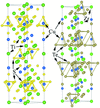issue contents
September 2018 issue

Cover illustration: Two nitrophenyl-substituted secondary amines have been synthesized and characterized by single-crystal X-ray diffraction, 1H NMR, IR and mass spectrometry. Following nitrosation of the amine groups via reaction with NaNO2, NO release was measured for each compound over time and the results gauged against the number of NO-donor sites. See Badour, Arnett-Butscher, Mohanty, Squattrito, Lambright & Kirschbaum [Acta Cryst. (2018), C74, 1038-1044].
research papers






















 journal menu
journal menu



























